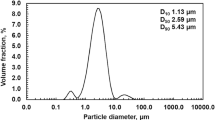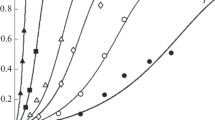Abstract
The pH-dependence of oxide dissolution rates is controlled by Brønsted acid-base reactions at the mineral surface. These reactions are rapid but depend explicitly on temperature, as do the subsequent slow rates of bond hydrolysis. The net result is that dissolution rates vary in a complicated fashion with temperature and solution pH. The enthalpy changes of acid-base reactions on oxide materials are sufficiently similar, however, that general statements can be made about their contribution. The enthalpy changes from proton adsorption to a hydroxyl functional group (▸SOH), or to a deprotonated functional group (▸SO −), are generally exothermic. The enthalpy changes become increasingly endothermic, however, as charge accumulates on the mineral surface and the charged species interact electrostatically. The result is that mineral dissolution rates are least sensitive to temperature, as measured with an Arrhenius-like rate law, at pH conditions near the Point of Zero Net Proton Charge.
Similar content being viewed by others
References
Astumian, R.D., M. Sasaki, T. Yasunaga and Z.A. Schelly 1981. Proton adsorption-desorption kinetics on iron oxides in aqueous suspensions, using the pressure-jump method. J. Phys. Chem. 85:3832–3835.
Atkinson, R.J., A.M. Posner and J.P. Quirk, 1967. Adsorption of potential-determining ions at the ferric oxide-aqueous electrolyte interface. J. Phys. Chem. 71:550–558.
Bates, R.G., 1973. Determination of pH, Theory and Practice. Wiley Interscience, Chapter 4.
Bidinosti, D.R. and W.J. Biermann, 1956. A redetermination of the relative enthalpies of aqueous perchloric acid solutions from 1 to 24 molal. Can. J. of Chem. 34:1591–1594.
Blesa M.A., A.J.G. Maroto and A.E. Regazzoni, 1990. Surface acidity of metal oxides immersed in water: A critical analysis of thermodynamic data. J. Coll. Interface Sci. 140:287–290.
Brady, P.V., 1992. Silica surface chemistry at elevated temperatures. Geochim. Cosmochim. Acta 56: 2941–2946.
Brady, P.V. and J.V. Walther, 1989. Controls on silicate dissolution rates in neutral and basic pH solutions at 25°C. Geochim. Cosmochim. Acta 53:2823–2830.
Brady, P.V. and J.V. Walther, 1992. Surface chemistry and silicate dissolution at elevated temperatures. American Jour. Sci. 292:639–658.
Casey, W.H. and H.R. Westrich, 1992. Control of dissolution rates of orthosilicate minerals by divalent metal-oxygen bonds. Nature 355:157–158.
Casey, W.H. and G. Sposito, 1992. On the temperature dependence of mineral dissolution rates. Geochim. Cosmochim. Acta 56:3825–3830.
Fokkink, L.G.J., 1987. Ion adsorption on oxides. Ph.D. dissertation, Landbouwuniversiteit te Wageningen, The Netherlands.
Furrer, G. and W. Stumm, 1986. The coordination chemistry of weathering: I. Dissolution kinetics ofδ-Al2O3 and BeO. Geochim. Cosmochim. Acta 50:1847–1860.
Hansen, L.D. and Lewis, E.A., (1971). The evaluation of aqueous TRIS solutions as a chemical standard for titration calorimetry. J. Chem. Thermo. 3, 35–41.
Lövgren, L., S. Sjöberg and P.W. Schindler, 1990. Acid-base reactions and Al(III) complexation at the surface of goethite. Geochim. Cosmochim. Acta 54:1301–1306.
Machesky, M.L. and M.A. Anderson, 1986. Calorimetric acid-base titrations of aqueous goethite and rutile suspensions. Langmuir 2:582–587.
Machesky, M.L. and P.F. Jacobs, 1991a. Titration calorimetry of aqueous alumina suspensions Part I: Results and comparision with similar studies. Colloids and Surfaces 53:297–314.
Machesky, M.L. and P.F. Jacobs, 1991b. Titration calorimetry of aqueous alumina suspensions Part II: Discussion of enthalpy changes with pH and ionic strength. Colloids and Surfaces 53:315–328.
Mehr, S.R., D.J. Eatough, L.D. Hansen and E.A. Lewis, 1989. Calorimetry of heterogeneous systems: H+ binding to TiO2 in NaCl. Thermochim. Acta 154:129–143.
Richards, T.W. and A.W. Rowe, 1922. The heats of neutralization of potassium, sodium and lithium hydroxides with hydrochloric, hydrobromic, hydroiodic and nitric acids at various dilutions. J. Amer. Chem. Soc. 44:684–707.
Schindler, P.W. and H.R. Kamber, 1968. The Acidität von Silanolgruppen. Helv. Chim. Acta 51: 1781–1786.
Schindler, P.W., 1967. Heterogeneous equilibria involving oxides, hydroxides, carbonates, and hydroxide carbonates in: Adv. in Chem. Series 67, Equilibrium Concepts in Natural Water Systems, American Chemical Society, Washington D.C. pp. 196–221.
Sposito, G., 1983. On the surface complexation model of the oxide aqueous solution interface. J. Coll. Interf. Sci. 91:329–340.
Wieland, E.B., B. Wehrli and W. Stumm, 1988. The coordination chemistry of weathering III. Generalization on the dissolution rates of minerals. Geochim. Cosmochim. Acta 52, 1969–1981.
Author information
Authors and Affiliations
Rights and permissions
About this article
Cite this article
Casey, W.H., Cheney, M.A. Brønsted reactions on oxide mineral surfaces and the temperature-dependence of their dissolution rates. Aquatic Science 55, 304–313 (1993). https://doi.org/10.1007/BF00877275
Received:
Accepted:
Issue Date:
DOI: https://doi.org/10.1007/BF00877275




